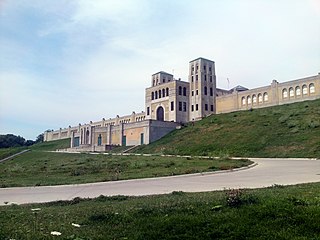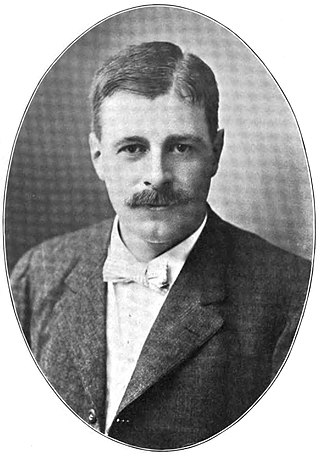Related Research Articles

A water filter removes impurities by lowering contamination of water using a fine physical barrier, a chemical process, or a biological process. Filters cleanse water to different extents, for purposes such as: providing agricultural irrigation, accessible drinking water, public and private aquariums, and the safe use of ponds and swimming pools.

The City Hall-County Building, commonly known as City Hall, is a 12-story building in Chicago, Illinois that houses the seats of government of the City of Chicago and Cook County. The building's west side holds the offices of the mayor, city clerk, and city treasurer; some city departments; offices of alderpersons of Chicago's 50 wards; and the Chicago City Council's chambers. The building's east side houses offices of the Government of Cook County, including the Cook County Board of Commissioners' chambers.

The R. C. Harris Water Treatment Plant in Toronto, Ontario, Canada, is both a crucial piece of infrastructure and an architecturally acclaimed historic building named after the longtime commissioner of Toronto's public works Roland Caldwell Harris. The plant's architect was Thomas C. Pomphrey with engineers H.G. Acres and William Gore. It is located in the east of the city at the eastern end of Queen Street and at the foot of Victoria Park Avenue along the shore of Lake Ontario in the Beaches neighbourhood in the former city of Scarborough.

Eugene Sawyer Jr. was an American businessman, educator, and politician. Sawyer was selected by the Chicago City Council as the 53rd Mayor of Chicago, Illinois after the sudden death of then–mayor Harold Washington. Sawyer served for the remainder of the term, from December 2, 1987 until April 24, 1989. A member of the Democratic Party, Sawyer was an alderman, and the second African-American to serve as mayor of Chicago.

Toronto Water is the municipal division of the City of Toronto under Infrastructure and Development Services responsible for the water supply network, and stormwater and wastewater management in Toronto, Ontario, Canada, as well as parts of Peel and York Regions.

A combination of aqueducts, reservoirs, and tunnels supplies fresh water to New York City. With three major water systems stretching up to 125 miles (201 km) away from the city, its water supply system is one of the most extensive municipal water systems in the world.

The Metropolitan Water Reclamation District of Greater Chicago (MWRD), originally known as the Sanitary District of Chicago, is a special-purpose district chartered to operate in Cook County, Illinois since 1889. Although its name may imply otherwise, it is not a part of the City of Chicago's local government but is created by Illinois state government with an elected Board of Commissioners. The MWRD's main purposes are the reclamation and treatment of wastewater and flood water abatement in Cook County to protect the health and safety of citizens and of area waterways. In 1900, the District notably reversed the flow of the Chicago River, and it is currently involved in the large multi-decade construction of the "Deep Tunnel," Tunnel and Reservoir Plan (TARP).

The McMillan Reservoir is a reservoir in Washington, D.C., that supplies the majority of the city's municipal water. It was originally called the Howard University Reservoir or the Washington City Reservoir, and was completed in 1902 by the U.S. Army Corps of Engineers.

The water cribs in Chicago are structures built to house and protect offshore water intakes used to supply the City of Chicago with drinking water from Lake Michigan. Water is collected and transported through tunnels located close to 200 feet (61 m) beneath the lake, varying in shape from circular to oval, and ranging in diameter from 10 to 20 feet. The tunnels lead from the water cribs to Pumping Stations located onshore, then to water purification plants Jardine Water Purification Plant and the Sawyer Water Purification Plant, where the water is then treated before being pumped to all parts of the city as well as 118 suburbs.
The 1993 Milwaukee cryptosporidiosis outbreak was a significant distribution of the Cryptosporidium protozoan in Milwaukee, Wisconsin, and the largest waterborne disease outbreak in documented United States history. It is suspected that The Howard Avenue Water Purification Plant, one of two water treatment plants in Milwaukee at the time, was contaminated. It is believed that the contamination was due to an ineffective filtration process. Approximately 403,000 residents were affected resulting in illness and hospitalization. Immediate repairs were made to the treatment facilities along with continued infrastructure upgrades during the 25 years since the outbreak. The total cost of the outbreak, in productivity loss and medical expenses, was $96 million. At least 69 people died as a result of the outbreak. The city of Milwaukee has spent upwards to $510 million in repairs, upgrades, and outreach to citizens.

Promontory Point is a man-made peninsula jutting into Lake Michigan. It is located in Chicago's Burnham Park. The Point was constructed from landfill and by the late 1930s was protected by a seawall or revetment. The revetment was designed and constructed by Chicago Park District engineers and consists of limestone blocks arranged in a series of four steps leading to a promenade.

The Jardine Water Purification Plant, formerly the Central District Filtration Plant, is a water filtration plant located at 1000 East Ohio Street, north of Navy Pier in Chicago, Illinois. It draws raw water from two of the city's water cribs far offshore in Lake Michigan and supplies two thirds of City of Chicago consumers in the northern, downtown, and western parts of the city and to many northern and western surrounding suburbs.

The New Croton Aqueduct is an aqueduct in the New York City water supply system in Westchester County, New York carrying the water of the Croton Watershed. Built roughly parallel to the Old Croton Aqueduct which it originally augmented, the new aqueduct opened in 1890. The old aqueduct remained in service until 1955, when supply from the Delaware and Catskill Aqueducts was sufficient to allow taking it off line.
The Chicago Center for Green Technology was a 34,000-square-foot (3,200 m2) US Green Building Council LEED Platinum certified building located on a plot of 17 acres (69,000 m2) in Chicago's East Garfield Park Community built to showcase green technologies. This was the first municipal and brownfield site to win a LEED Platinum award. This project was completed as part of Mayor Richard M. Daley's Chicago Brownfield Initiative (CBI). The center offered workshops focusing on green technology and sustainable design, a green building resource center, and self-guided or guided tours to visitors.

George Warren Fuller was an American sanitary engineer who was also trained in bacteriology and chemistry. His career extended from 1890 to 1934 and he was responsible for important innovations in water and wastewater treatment. He designed and built the first modern water filtration plant, and he designed and built the first chlorination system that disinfected a U.S. drinking water supply. In addition, he performed groundbreaking engineering work on sewage treatment facilities in the U.S. He was President of both the American Water Works Association and the American Public Health Association, and he was recognized internationally as an expert civil and sanitary engineer.

Allen Hazen was an American civil engineer and an expert in hydraulics, flood control, water purification and sewage treatment. His career extended from 1888 to 1930, and he is, perhaps, best known for his contributions to hydraulics with the Hazen-Williams equation. Hazen published some of the seminal works on sedimentation and filtration. He was President of the New England Water Works Association and Vice President of the American Society of Civil Engineers.
John Robert Baylis was an American chemist and sanitary engineer. His career extended from about 1905 to 1963 and he is best known for his work in applied research to improve drinking water purification.

Generally, the Chicago Harbor comprises the public rivers, canals, and lakes within the territorial limits of the City of Chicago and all connecting slips, basins, piers, breakwaters, and permanent structures therein for a distance of three miles from the shore between the extended north and south lines of the city. The greater Chicago Harbor includes portions of the Chicago River, the Calumet River, the Ogden Canal, the Chicago Sanitary and Ship Canal, Lake Calumet, and Lake Michigan.

The Croton Water Filtration Plant, is a drinking water treatment facility in New York City which began operation in 2015. The plant construction cost was over $3 billion, The facility was built 160 feet (49 m) under Van Cortlandt Park's Mosholu Golf Course in the Bronx.
References
- ↑ "Chicago Water Department". City of Chicago. 2019. Retrieved February 6, 2019.
- 1 2 3 Cain, Louis P. (2004). "Sanitation in Chicago: A Strategy for a Lakefront Metropolis". The Encyclopedia of Chicago. Retrieved August 20, 2020.
- 1 2 "Water Treatment". Chicago Department of Water Management, Education. 2010. Retrieved August 20, 2020.
- 1 2 "Water". Chicago Department of Water Management, Education Overview (video). 2010. Retrieved August 20, 2020.
- 1 2 "Water purification plant renamed for former Chicago Mayor Eugene Sawyer". ABC News 7. September 19, 2016. Retrieved February 6, 2019.
- ↑ Buckshon, Mark (July 6, 2020). "Work starts on $74.5 million renovation at Eugene Sawyer Water Filtration Plant". Chicago Construction News. Retrieved August 21, 2020.